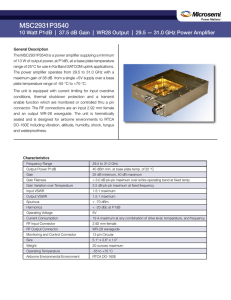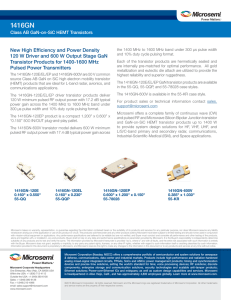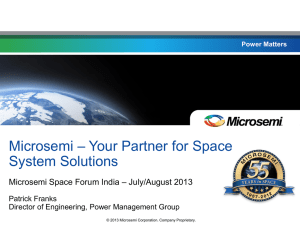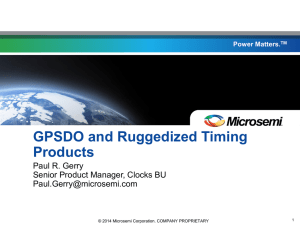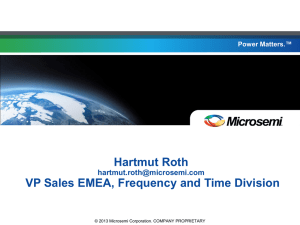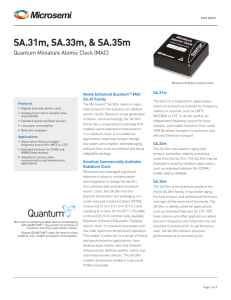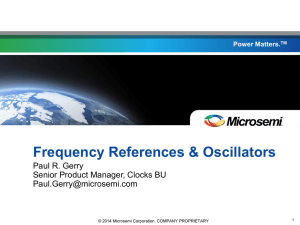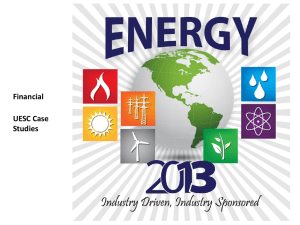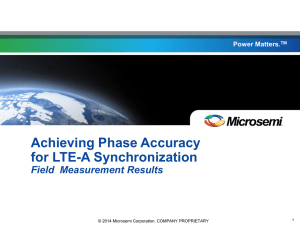Power Matters. TM
advertisement
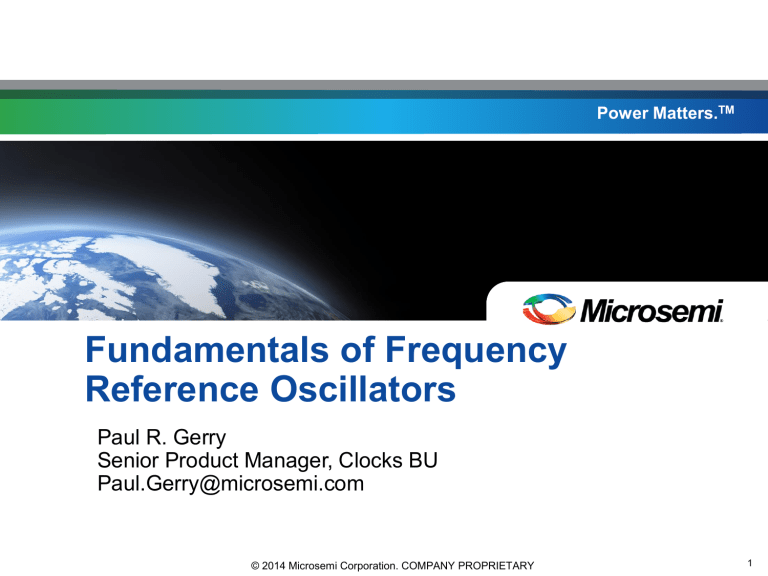
Power Matters.TM Fundamentals of Frequency Reference Oscillators Paul R. Gerry Senior Product Manager, Clocks BU Paul.Gerry@microsemi.com © 2014 Microsemi Corporation. COMPANY PROPRIETARY 1 For Frequency Generation You need… The Earth rotating Electronic Oscillator A pendulum (mechanical oscillator) Atomic resonance … a method of generating a repeatable event © 2014 Microsemi Corporation. COMPANY PROPRIETARY Power Matters.TM 2 What is Frequency Frequency = the number of cycles per second Ideal frequency source generates a pure, repeatable sine wave © 2014 Microsemi Corporation. COMPANY PROPRIETARY Power Matters.TM 3 Related Frequency Definitions Offset – the frequency error from the ideal (fast or slow) Accuracy – refers to frequency offset of a device Stability – how well an oscillator produces time or frequency over a given time interval Aging – change of frequency over time (also called drift) Temperature Stability – the change of frequency over temperature Accumulated Time Error – total of all the above characteristics acting on a clock © 2014 Microsemi Corporation. COMPANY PROPRIETARY Power Matters.TM 4 Performance Definitions Short Term Stability – the change of frequency over 1-100 seconds from noise and vibration. Sometimes called flicker or jitter Long Term Stability – the change of frequency over hours, days, or months. Result due to age and temperature Phase Noise – The rapid, short-term, random fluctuations in the phase of a sine wave due to oscillator quality, semiconductor and white noise © 2014 Microsemi Corporation. COMPANY PROPRIETARY Power Matters.TM 5 What is Frequency Stability & Accuracy Courtesy John Vig © 2014 Microsemi Corporation. COMPANY PROPRIETARY Power Matters.TM 6 Oscillator Stability Over Time Frequency stability typically improves in the short term, stabilizes, then becomes less predictable in the long term © 2014 Microsemi Corporation. COMPANY PROPRIETARY Power Matters.TM 7 Short and Long Term Oscillator Stability Frequency Stability Chart 1.00E-06 1.00E-07 1.00E-08 Stability 1.00E-09 OCXO 1.00E-10 1.00E-11 Hi-Stab OCXO 1.00E-12 Rb 1.00E-13 1.00E-14 Cs-High Perf 1.00E-15 1 Sec 10 Sec 100 Sec 1K Sec 10K Sec 100K Sec Week Month H-Maser GPS Time Some oscillators perform better short term… others long term © 2014 Microsemi Corporation. COMPANY PROPRIETARY Power Matters.TM 10 What is Phase Noise Unwanted noise sidebands on either side of the output signal center frequency caused by random variations of the frequency and the phase of the carrier © 2014 Microsemi Corporation. COMPANY PROPRIETARY Power Matters.TM 11 What is Single Side Band Phase Noise The SSB is defined as the ratio of power in one phase modulation sideband to the total signal power © 2014 Microsemi Corporation. COMPANY PROPRIETARY Power Matters.TM 12 What is Oscillator Phase Noise Noise Level (dBc/Hz) Oscillator Phase Noise -80 -90 -100 -110 -120 -130 -140 -150 -160 1Hz OCXO Rb H-Maser 10Hz Hi-Stab OCXO Cs 100Hz 1KHz 10KHz Offset Frequency Phase noise is a short term noise component indicative of the spectral purity of an oscillator signal © 2014 Microsemi Corporation. COMPANY PROPRIETARY Power Matters.TM 13 Putting the Fundamentals into Perspective… What is one part in 1.0E-10 ? (As in 1 x 10-10/day aging) • ~1/2 cm out of the circumference of the Earth. • ~1/4 second per human lifetime (of ~80 years). Power received on Earth from a GPS satellite, -160 dBW, is as “bright” as a flashlight in Los Angeles when viewed in New York City, ~5000 km away What is -170 dB? (As in -170 dBc/Hz phase noise) • -170 dB = 1 part in 1017 ~thickness of a sheet of paper out of the total distance traveled by all the cars in the world in a day The second is the most precise SI unit of measure! © 2014 Microsemi Corporation. COMPANY PROPRIETARY Power Matters.TM 14 Frequency Sources Types Quartz Crystal Oscillators Atomic Frequency Standards Emerging Clock Technologies © 2014 Microsemi Corporation. COMPANY PROPRIETARY Power Matters.TM 15 Crystal Oscillator Types f f +10 ppm Voltage Tune Output -450C Crystal Oscillator (XO) Temperature Sensor Compensation Network or Computer 250C +1000C T -10 ppm -450C f f +1 ppm +1000C T XO -1 ppm Temperature Compensated (TCXO) Oven Oven control XO Temperature Sensor -450C f f +1 x 10-8 -1 x 10-8 +1000C T Oven Controlled (OCXO) © 2014 Microsemi Corporation. COMPANY PROPRIETARY Power Matters.TM 16 Atomic Frequency Standards © 2014 Microsemi Corporation. COMPANY PROPRIETARY Power Matters.TM 17 Atomic Clock Technologies Rubidium Gas Cell: Cesium Beam: Hydrogen Maser: 6,834,682,610.904 Hz 9,192,631,770 Hz 1,420,405,751.768 Hz Fountains use cesium, rubidium Stored Ions use mercury, ytterbium Optical Clocks use mercury, calcium The resonant frequency of atoms does not age… the apparatus to interrogate or confine atoms can in some atomic clocks © 2014 Microsemi Corporation. COMPANY PROPRIETARY Power Matters.TM 18 Atomic (Passive) Clock Basics Synthesizer Atoms Detector RF Output Oscillator Servo Divider Clock Output Stimulate an energy state change in the atoms Detect when resonant frequency is achieved Servo the oscillator to maintain optimal performance © 2014 Microsemi Corporation. COMPANY PROPRIETARY Power Matters.TM 19 Cesium Technology Applications Cesium Technology is considered the most comprehensive holdover option against GNSS vulnerabilities • Exhibit no frequency drift • Maintains 5x10-15 accuracy over the life of the instrument Critical for long-term autonomous operation No on-going calibration required More expensive than Rubidium and OCXO • Consumes more power and space Typical applications • Fixed wireline communications infrastructure • Under sea (Submarine) • Satellite ground stations • Metrology and Time Keeping © 2014 Microsemi Corporation. COMPANY PROPRIETARY Power Matters.TM 20 Rubidium Frequency Standards (Lamp) Magnetic Shield Lamp Oven Lamp Lamp Exciter Rb-87 Lamp Coil Filter Oven Cavity Oven Filter Absorption Rb-85 Rb-87 Cell Cell C-Field Coil RF Excitation PhotoDetector Signal Out C-Field Current (3) Oven Temperature Sensors and Heaters W Interrogation Physics Package RF Chain Servo Modulation Discriminator Signal Frequency Lock Loop O/P Servo Amplifier Crystal Oscillator O/P Amp Control Voltage © 2014 Microsemi Corporation. COMPANY PROPRIETARY Power Matters.TM 21 Rubidium Frequency Standards (CPT) The MAC uses Coherent Population Trapping (CPT) Coherent Population Jinquan Deng, Peter Vlitas, Dwayne Taylor, Larry Perletz, and Robert Lutwak, "A COMMERCIAL CPT RUBIDIUM CLOCK“ EFTF 2008 Toulouse, France. Trapping (CPT) interrogation of Rubidium Laser diode (VCSEL) modulated to achieve CPT resonance Photodiode detects the CPT resonance 10 MHz VCXO synthesizes 3.4 GHZ microwaves Microwave frequency is locked to CPT resonance signal stabilizing the output to 10 MHZ © 2014 Microsemi Corporation. COMPANY PROPRIETARY Power Matters.TM 22 Rubidium Gas Cell Frequency Standards Most widely used type of atomic clock • Smallest, lightest, lowest power • Least complex, least expensive, longest life • Excellent performance, stability & reliability Device of choice when better stability is needed compared to crystal oscillator • Lower aging, lower temperature sensitivity • Faster warm-up, excellent retrace • Used as an inexpensive holdover technology © 2014 Microsemi Corporation. COMPANY PROPRIETARY Power Matters.TM 23 Emerging Clock Technologies Fountain Clocks • Atoms are cooled and “tossed” upward in Earth’s gravity • Used for primary standards where ultimate accuracy is desired Coherent Population Trapping Clocks: Miniature Atomic Clocks (MAC) & CSAC • Ultra miniature size and low power requirement-SWaP Optical clocks relying upon optical atomic transitions © 2014 Microsemi Corporation. COMPANY PROPRIETARY Power Matters.TM 24 SA.31m Laser Pumped Rb & Chip Scale Atomic Clock (CSAC) Rb Miniature Atomic Clock (MAC) • Small form factor: 51mm x 51mm x 18mm (H) • Lower power: 5W @ 25o C • Stability – 1s <3E-11; 100s <8E-12 • Aging: <3E-10/month • Temp Stability: <1E-10 (–10o C to +75oC) CSAC (Chip Scale Atomic Clock) • • • • Volume: <17 cc Weight : 35g Very Low power: <120 mW Stability – 1s <2E-10; 100s <2E-11 • Aging: <3E-10/month • Temp Stability: <5E-10 (0 to +75o C) © 2014 Microsemi Corporation. COMPANY PROPRIETARY Power Matters.TM 25 Hierarchy of Oscillator Types Oscillator Type* Accuracy** Typical Applications • Crystal oscillator (XO) 10-5 to 10-4 Computer timing • Temperature compensated crystal oscillator (TCXO) 10-6 Frequency control in tactical radios • Microcomputer compensated crystal oscillator (MCXO) 10-8 to 10-7 Spread spectrum system clock • Oven controlled crystal oscillator (OCXO) 10-8 (with 10-10 per g option) Navigation system clock & frequency standard, MTI radar • Small atomic frequency standard (Rb, MAC, CSAC) 10-9 C3 satellite terminals, bistatic, & multistatic radar, T&M Communications • High performance atomic standard (Cs) 10-12 to 10-11 Strategic C3, EW * Sizes range from <5cm3 for clock oscillators to > 30 liters for Cs standards Costs range from <$5 for clock oscillators to > $50,000 for Cs standards ** Including environmental effects (e.g., -40oC to +75oC) and one year of aging © 2014 Microsemi Corporation. COMPANY PROPRIETARY Power Matters.TM 26 Frequency and Time Relationship © 2014 Microsemi Corporation. COMPANY PROPRIETARY Power Matters.TM 27 Time is Derived from Frequency Every clock ever made is an oscillator + a counter The 1 pulse-per-second (PPS) is the epoch or definition of the on-time marker of a clock Further counting of the 1PPS is used to keep track of seconds, minutes, hours, days, and years OSC Counter 1PPS FAST / EARLY SLOW / LATE 1PPS Clock 1PPS rising edge is typically on-time: HH:MM:SS.000000000 © 2014 Microsemi Corporation. COMPANY PROPRIETARY Power Matters.TM 28 Accumulated Time Error in Oscillators Microseconds Clock operating from an OCXO with an offset & aging of 5E-10 and a temperature error of 1 degree C Accumulated Time Error 400 350 300 250 200 150 100 50 0 1 5 9 13 17 21 Aging Error(uS) Offset Err.(uS) Temp Err.(uS) Total Err.(uS) 25 29 33 37 41 45 49 53 57 Hours Oscillator errors accumulate impacting clock performance © 2014 Microsemi Corporation. COMPANY PROPRIETARY Power Matters.TM 29 Cesium Time Error Due to Offset Cesium Time Error (Offset 2E-12) 6 Microseconds 5 Time error = Freq offset * seconds/day Or 2E-12 x 86400s = ~0.2µs / day 4 3 2 1 0 1 4 7 Offset Err.(uS) 10 13 16 19 22 25 28 31 Days Cesium atomic oscillators do not age © 2014 Microsemi Corporation. COMPANY PROPRIETARY Power Matters.TM 30 GPS Disciplining Phase Plot If we look at the phase error over time we can see just how the Stability and Accuracy are linked TCXO Disciplining OCXO Disciplining Rubidium Disciplining Cesium Disciplining Nanoseconds +150 +100 +50 0 -50 -100 -150 TIME Oscillator is key to improving GPS clock performance © 2014 Microsemi Corporation. COMPANY PROPRIETARY Power Matters.TM 31 Thank You Ramki Ramakrishnan Director of Marketing & Business Dev, Clocks BU ramki.ramakrishnan@microsemi.com +1 707-636-1914 Paul R. Gerry Senior Product Manager, Clocks BU Paul.Gerry@microsemi.com +1 978-522-5798 Steve Fossi VP and General Manager, Clocks BU Steve.Fossi@microsemi.com +1 707-636-1810 © 2014 Microsemi Corporation. COMPANY PROPRIETARY Power Matters.TM 32 References • NIST http://www.nist.gov/index.html • USNO http://www.usno.navy.mil/USNO/about-us • JPO http://www.jpo.go.jp/ • Time and Frequency User's Manual, National Bureau of Standards Special Publication 559, U.S. Government Printing Office, Washington, DC, 1979 © 2014 Microsemi Corporation. COMPANY PROPRIETARY Power Matters.TM 33
